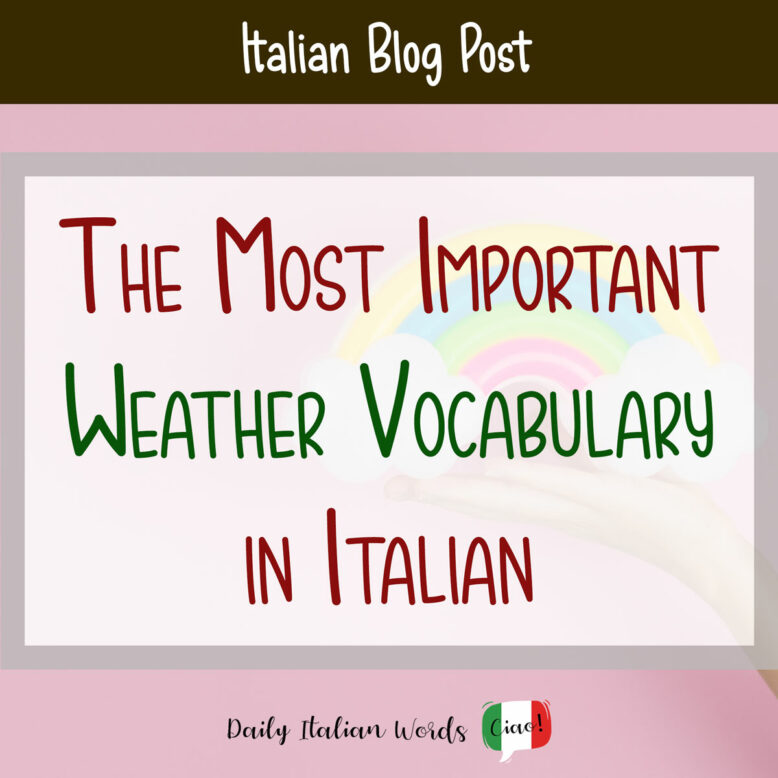Some say that British people are obsessed with the weather, but this is a favourite topic of discussion in many other parts of the world, too, and Italy is no exception. Most Italian regions are blessed with warm, sunny weather for several months a year, and Italians are particularly worried about getting caught in a rainstorm without an umbrella or — heaven forbid! — being exposed to air drafts and cold wind. Due to its diverse geography and its elongated shape, Italy also experiences extremely varied and contrasting climates in spite of its small size.

How to talk about the weather in Italian?
First of all, there is the word tempo, which means both time and weather. The Latins clearly differentiated these two concepts using two separate words: tĕmpus indicated chronological time, while tempestas indicated the weather. The root of these terms is the same, of course, and the overlapping of their meanings is apparent in the Italian word temporale, an adjective that indicates something that has to do with time, like the English temporal, but also a noun that means thunderstorm.
When you say tempo the meaning is usually clarified by the context, but if you want to specify that you are talking about the weather, you can say tempo meteorologico, or simply il meteo. This word also indicates the weather forecast:
Cosa dice il meteo?
What does the weather forecast say?
We can describe the weather and the weather forecast in many different ways, but usually the sentence goes like this: fa bel tempo, fa brutto tempo, literally, it makes good weather, it makes bad weather. So we can say:
Che tempo fa?
How is the weather?
(literally: What kind of weather does it make?)
Che tempo farà domani?
What will the weather be like tomorrow?
And the easiest way to answer these questions is:
Oggi fa bel tempo. / Oggi fa bello.
(here the word tempo is implied)
The weather is nice today.
Oggi fa brutto tempo / Oggi fa brutto.
The weather is bad today.
Domani farà bello/brutto.
The weather will be good/bad tomorrow.

Although we usually talk of the weather as beautiful (bello) or ugly (brutto), we can also describe it as good (buono) or bad (cattivo). There is actually a special word for bad weather: maltempo. Some common sentences that you can encounter include:
- Oggi il tempo è buono. = The weather is nice today.
- Oggi c’è cattivo tempo. = There is bad weather today.
- Il maltempo continuerà per un’altra settimana. = The bad weather will continue for another week.
- Il maltempo non dà tregua. = The bad weather gives no respite. / There is no break in the bad weather.
Weather presenters love this final expression! The weather forecast often mentions atmospheric pressure too: bassa pressione, low pressure, which often brings rain, and alta pressione, high pressure, usually associated with warm weather. For some examples of weather forecasts in Italian, you can have a look at our video on weather vocabulary.
But what is bel tempo and brutto tempo for Italians? The idea of good and bad weather varies widely depending on which part of Italy you are from. A chilly, misty day with no rain can still be nice for someone from Milan and awful for a Sicilian, but usually, even after prolonged droughty periods, most Italians think of the rain as an evil thing that must be avoided at all costs. Although there is no Italian equivalent to the English expression “rain check”, even a few drops of rain are the number one excuse to avoid a meeting:
Oggi piove, non esco!
It’s raining today, I’m staying home!
Other expressions related to the rain include:
- Sta per piovere. = It’s going to rain. / It’s about to rain.
- Ha smesso di piovere. = It’s stopped raining.
- Diluvia! = It’s pouring!
The verb diluviare comes from diluvio, deluge, which brings to mind the image of Noah braving the flood on his ark: il diluvio universale. But even with current changes in climate, there is no monsoon season in Italy yet, so this might be a slight exaggeration!
The temperature is also very important: no one wants to be caught in chilly weather without a coat, and maybe even a scarf and a hat. Here, again, we can use the verb fare:
Fa caldo. / Fa freddo.
It’s hot. / It’s cold.

Or, if you want to be more emphatic:
- Fa caldissimo/freddissimo. = It’s very hot/cold.
- Fa un caldo/freddo terribile! = It’s terribly hot/cold!
- Si gela! = It’s freezing cold!
- Fa un freddo cane! = It’s freezing cold! (literally: it’s dog cold)
What about the word fresco? It means chilly, but usually in a pleasant way, like a fresh breeze that provides respite from the heat:
Finalmente c’è un po’ d’aria fresca.
Finally there is a nice cool breeze.
With the addition of suffixes, fresco can become a little less pleasant:
- Oggi fa freschino/freschetto. = It’s a bit chilly today.
To alter the meaning of a word, you can pair it with an adjective or add a suffix to it; Italians usually go for the latter:
- vento —> ventaccio = wind —> strong wind
- vento —> venticello = wind —> breeze
- pioggia —> pioggerellina = rain —> light rain
Unlike English, which often uses the construction it’s + adjective, in Italian we use c’è (there is) + noun. A few examples:
- C’è vento. = It’s windy. (literally: there is wind)
- C’è il sole. = It’s sunny. (literally: there is sun)
- C’è nebbia. = It’s foggy. (literally: there is fog)
- C’è afa. = It’s muggy. (literally: there is humidity)
However, we use adjectives to describe the sky:
- Il cielo è nuvoloso / coperto. = The sky is cloudy.
- Il cielo è sereno / terso / soleggiato. = The sky is cloudless/clear/sunny.
Sereno also applies to people: it means calm and peaceful. Un cielo minaccioso, a threatening sky, on the other hand, usually brings bad news. Which words can we use to describe extremely bad weather? We have already seen the origin of the word temporale, thunderstorm, while from the Latin word for weather, tempestas, comes, of course, the word tempesta, tempest. Temporale and tempesta are two very similar phenomena, but generally temporale describes a storm with rain, thunder and lightning, while tempesta also involves very strong wind, usually out at sea.

Here are some other unpleasant weather events:
- neve = snow
- grandine = hail
- tuoni = thunder
- fulmini = lightning
- raffiche di vento = wind gusts
- mare mosso = rough sea
- banchi di nebbia = fog banks
La nebbia is very common in the North, especially in the Po Valley, where you can immediately tell outsiders from locals by the speed at which they drive in zero visibility conditions.
Below are some words for other weather events that you are unlikely to encounter in Italy, but that are still worth learning:
- tempesta di sabbia = sandstorm
- tromba d’aria = tornado (literally, air trumpet)
- uragano = hurricane
- ciclone = cyclone
We hope that you never experience extreme weather in Italy, but if you happen to encounter a spell of frightful weather, you will have the chance to sound like a local by casually dropping this idiomatic expression:
Che tempo da lupi!
This weather is fit for wolves!
Weather Vocabulary:
If you’d like to discover even more useful weather vocabulary in Italian, be sure to check out the video below!
My Italian Circle is a place where you can go to find engaging new ways to learn Italian, test and improve your listening skills, and maybe even make peace with Italian grammar. We create clear, accurate, authentic content every week on YouTube and Patreon.

Anna is a professional language teacher and Diana is a freelance translator. On their website and YouTube channel My Italian Circle, they create content for Italian learners, especially English speakers. They help with grammar, progression from beginner level, and offer insights into authentic everyday Italian, Italian culture, and lifestyle.


